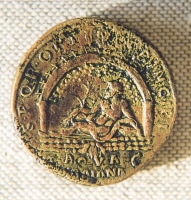
| For the photo's, see below |
| Home / the complete website |
 |
Early 2010 two filmmakers / amateur archaeologists claim to have found the source of the Aqua Traiana, see
|
The Sette Sale (Seven Halls) cisternThe water supply of Trajan's Baths was stored in a huge cistern - known since the Middle Ages as Sette Sale, the Seven Halls - that was fed by a branch aqueduct that came from the Esquiline hill. Located at the edge of the park, the cistern is well preserved (entrance on the Via delle Terme di Traiano). Since it is oriented differently than the Baths, it was once thought to have belonged to the Domus Aurea. However, the many brick stamps found in its wall prove that the cistern was built at the same time as the Baths.The cistern is on two levels, each consisting of nine parallel compartments more that 5 meter wide and 30 to 40 meters long (their length differ because of the curve of the eastern perimeter wall). The lower level stands directly on the ground supporting and elevating the upper level - the reservoir proper - which was therefore high enough to ensure that the water could flow out with enough pressure to supply the Baths. The cistern was partially embedded in the ground, so that the back curved wall and the two side walls are partially covered and buttressed by the embankment, while the straight front wall with alternating rectangular and semicircular niches was in sight. Later alterations made when the cistern was no longer in use, isolated the terrace and eliminated the connecting elements that adjusted for the difference in height between the front and back of the cistern. Large windows opened in the niches of the upper level provided ventilation. The water flowed out of pipes set in the low-level niches into a large conduit a stretch of which has been found in front of the northeastern exedra of the Baths. The compartments could hold over eight million liters of water. Their walls and floors are faced with waterproof plaster; they are interconnected by a system of staggered openings that prevent the formation of water currents or stagnation. The cistern has always been visible over the centuries. In the Middle Ages, one of its compartments was used as a burial area: more than a thousand skeletons were discovered here during the 1967 excavations. Text of the information panel in front of the cistern (May, 2010) |
| HOME | More literature on more aqueducts | Last modified: October, 2010 - Wilke D. Schram (w.d.schram@romanaqueducts.info) |